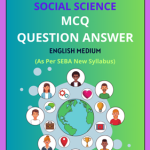SEBA Class 6 Social Science MCQ Chapter 24 The Local – Self Government Solutions in English Medium, Class 6 Social Science Multiple Choice Question Answer to each chapter is provided in the list so that you can easily browse throughout different chapters SEBA Class 6 Social Science MCQ Chapter 24 The Local – Self Government Question Answer and select need one.
SEBA Class 6 Social Science MCQ Chapter 24 The Local – Self Government
Also, you can read the SCERT book online in these sections SEBA Class 6 Social Science Objective Type Solutions by Expert Teachers as per SCERT (CBSE) Book guidelines. These solutions are part of SCERT All Subject Solutions. Here we have given Assam SEBA Class 6 Social Science MCQ Solutions for All Subject, You can practice these here.
The Local – Self Government
Chapter – 24
| MCQ |
1. What is the primary function of local self-government?
(a) Managing national defence.
(b) Conducting national elections.
(c) Addressing local issues and needs.
(d) Formulating state policies.
Answer: (c) Addressing local issues and needs.
2. Which is the smallest unit of local self-government in rural areas?
(a) District Council.
(b) Panchayat.
(c) Municipal Corporation.
(d) State Assembly.
Answer: (b) Panchayat.
3. What is the head of a Panchayat called?
(a) Sarpanch.
(b) Mayor.
(c) Governor.
(d) President.
Answer: (a) Sarpanch.
4. Which local self-government body is found in urban areas?
(a) Panchayat.
(b) Gram Sabha.
(c) Municipal Corporation.
(d) Block Samiti.
Answer: (c) Municipal Corporation.
5. Who elects the members of the Panchayat?
(a) State government.
(b) Local residents.
(c) National government.
(d) President.
Answer: (b) Local residents.
6. What is the term of office for Panchayat members?
(a) 2 years.
(b) 3 years.
(c) 4 years.
(d) 5 years.
Answer: (d) 5 years.
7. What is the role of a Gram Sabha?
(a) To make national laws.
(b) To manage urban infrastructure.
(c) To discuss and decide on local issues.
(d) To conduct state elections.
Answer: (c) To discuss and decide on local issues.
8. Which body is responsible for sanitation and water supply in a village?
(a) State government.
(b) Panchayat.
(c) National government.
(d) District Magistrate.
Answer: (b) Panchayat.
9. What is a Block Samiti?
(a) A village-level government body.
(b) An urban local government.
(c) A body at the block level coordinating multiple Panchayats.
(d) A national advisory body.
Answer: (c) A body at the block level coordinating multiple Panchayats.
10. Who is responsible for urban planning in a city?
(a) Panchayat.
(b) Gram Sabha.
(c) Municipal Corporation.
(d) Block Samiti.
Answer: (c) Municipal Corporation.
11. Which act provides for the establishment of Panchayats in India?
(a) The Panchayat Raj Act.
(b) The Municipal Act.
(c) The Gram Sabha Act.
(d) The Rural Development Act.
Answer: (a) The Panchayat Raj Act.
12. What is the role of a Mayor?
(a) Head of the Panchayat.
(b) Head of the Municipal Corporation.
(c) Member of the State Assembly.
(d) National government official.
Answer: (b) Head of the Municipal Corporation.
13. How often are elections held for local self-government bodies?
(a) Every 2 years.
(b) Every 3 years.
(c) Every 5 years.
(d) Every 6 years.
Answer: (c) Every 5 years.
14. Which body oversees education in urban areas?
(a) Panchayat.
(b) Block Samiti.
(c) Municipal Corporation.
(d) Gram Sabha.
Answer: (c) Municipal Corporation.
15. Who can participate in the meetings of the Gram Sabha?
(a) Only elected members.
(b) All adult residents of the village.
(c) Only government officials.
(d) Only state representatives.
Answer: (b) All adult residents of the village.

Hi! my Name is Parimal Roy. I have completed my Bachelor’s degree in Philosophy (B.A.) from Silapathar General College. Currently, I am working as an HR Manager at Dev Library. It is a website that provides study materials for students from Class 3 to 12, including SCERT and NCERT notes. It also offers resources for BA, B.Com, B.Sc, and Computer Science, along with postgraduate notes. Besides study materials, the website has novels, eBooks, health and finance articles, biographies, quotes, and more.




